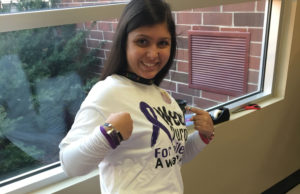Junior learns to live cautiously within epilepsy’s limitations

By: Tyler Campbell
Since the age of 14, junior Lauren Baker has been experiencing myoclonic seizures. She is one of many students who who experiences seizures and the the struggles that come along with epilepsy and the unpredictability they deliver.
“On Feb. 6, I was walking up the stairs and didn’t feel too well. After walking up the second flight of stairs, I blacked out and fell backwards,” Baker said explaining her first seizure.
Baker’s seizure lasted 45-60 seconds, and she was unconscious until the paramedics arrived, which took about 10 minutes. She was rushed to the hospital where it was explained to her that she had just suffered a grand mal seizure.
A grand mal seizure is a seizure caused by epilepsy that first causes someone to lose consciousness and then to start seizing. Though these seizures can be very short, they can be very dangerous as Baker got a goose egg on her head from the fall and multiple scratches all over her body from her flailing during the seizure.
The worst part for her however, was the testing at the hospital, which caused Baker to twitch and spaz, along with a lot of physical pain. She was diagnosed with juvenile myoclonic epilepsy, which she can grow out of.
Juvenile myoclonic epilepsy is a form of epilepsy that sends twitches throughout the body often associated with abnormal brain waves going through the myoclonus part of the brain. Episodes are normally caused by flashing lights.
Soon after Baker was released from the hospital, she learned that she had to be six months seizure free before she could get her learner’s permit, and she had to be one year seizure free to get her license.
“Along with that, I have to remember to take my medicine each morning and afternoon. I can’t be around strobe lights. Even changing medicine can be hard as they can make you sleepy, have severe mood changes or cause you to gain weight. You never know how the medicine will affect your body,” Baker said. “Along with all of this, if I don’t stay hydrated, I might begin to twitch due to myoclonic seizures. It’s very frustrating because not only is it scary driving to school and not knowing what will happen, it’s hard to face other people while twitching.”
Baker is just one of many students in the United States who is affected by epilepsy, as epilepsy is one of the most common neurological disorders in America, with one in 26 Americans being diagnosed with the condition.








You must be logged in to post a comment Login